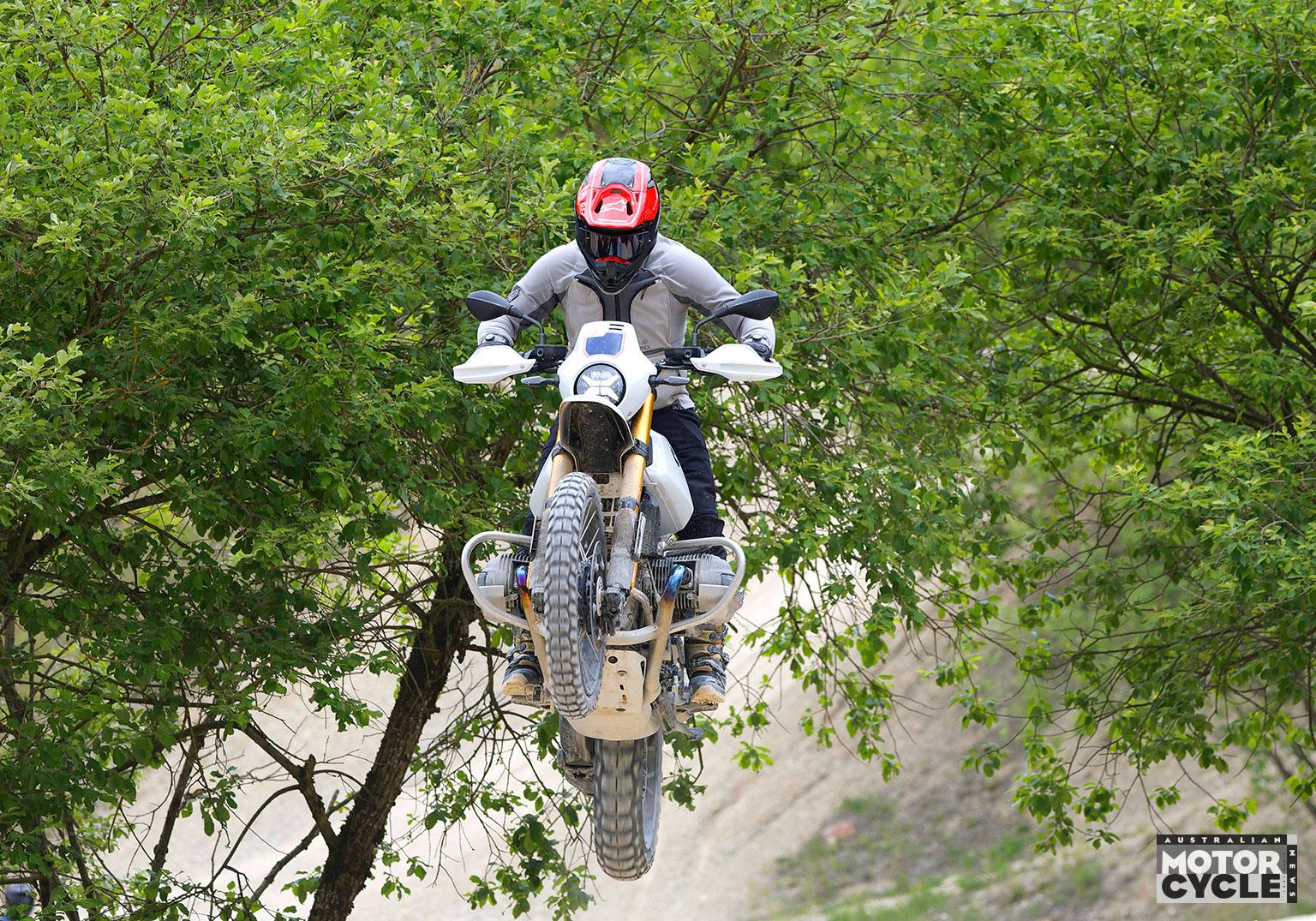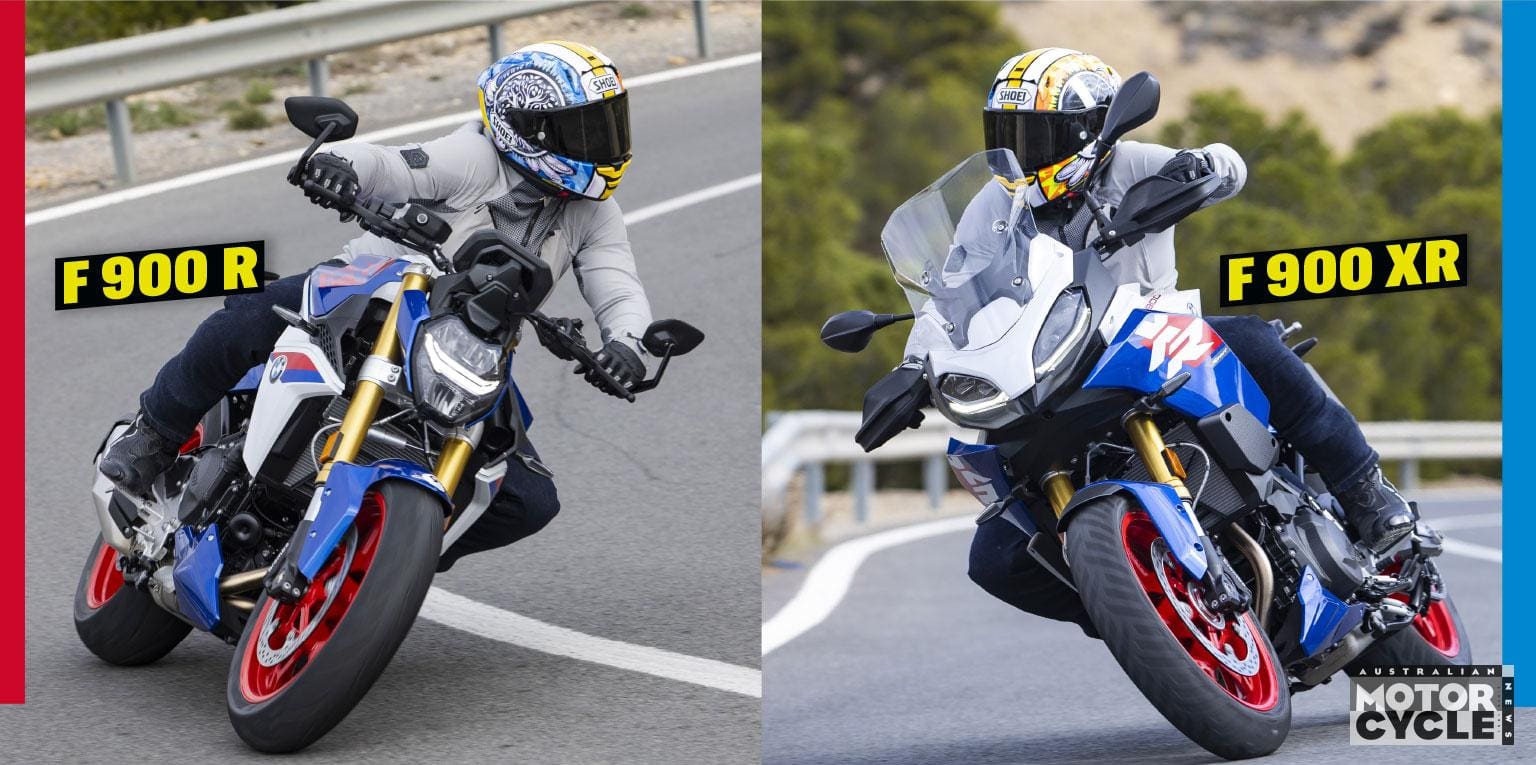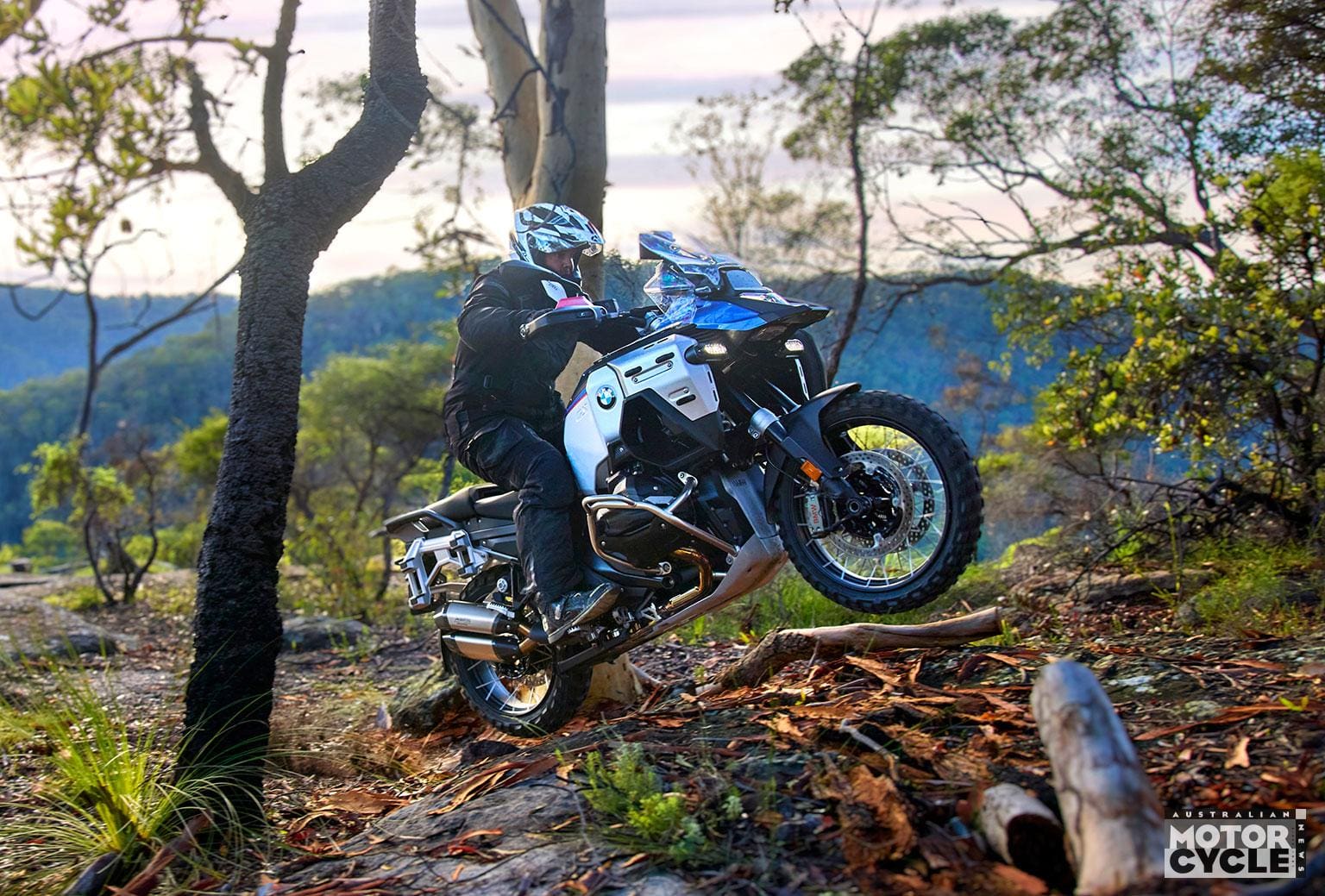The Ducati DesertX Rally is truly a DesertX on steroids, a road-legal ready-to-race bike with beefed-up, long-travel KYB suspension and little in terms of componentry and intent to separate it from the machine that won the twin-cylinder class of the recent Iron Road Prologue at the Erzbergrodeo. Its styling cues shift somewhat from desert raider to enduro – note the high-mount front mudguard – while paintless mass-coloured plastics and a forged carbon bashplate signal a tougher, more durable machine expected to take a few hits.
Like the base DesertX, the Rally is powered by the eminently versatile 937cc Testastretta 11° L-twin, which produces 81kW (108hp) at 9250rpm and 92Nm at 6500rpm. Ducati’s two-way quickshifter is standard and service intervals are every two years or every 15,000km, with valve clearance checks at 30,000km. On the electronics front, there are six riding modes stemming from four power modes, three levels of engine braking, eight traction control settings, three levels of cornering ABS and switchable wheelie control.
So plenty to play with.
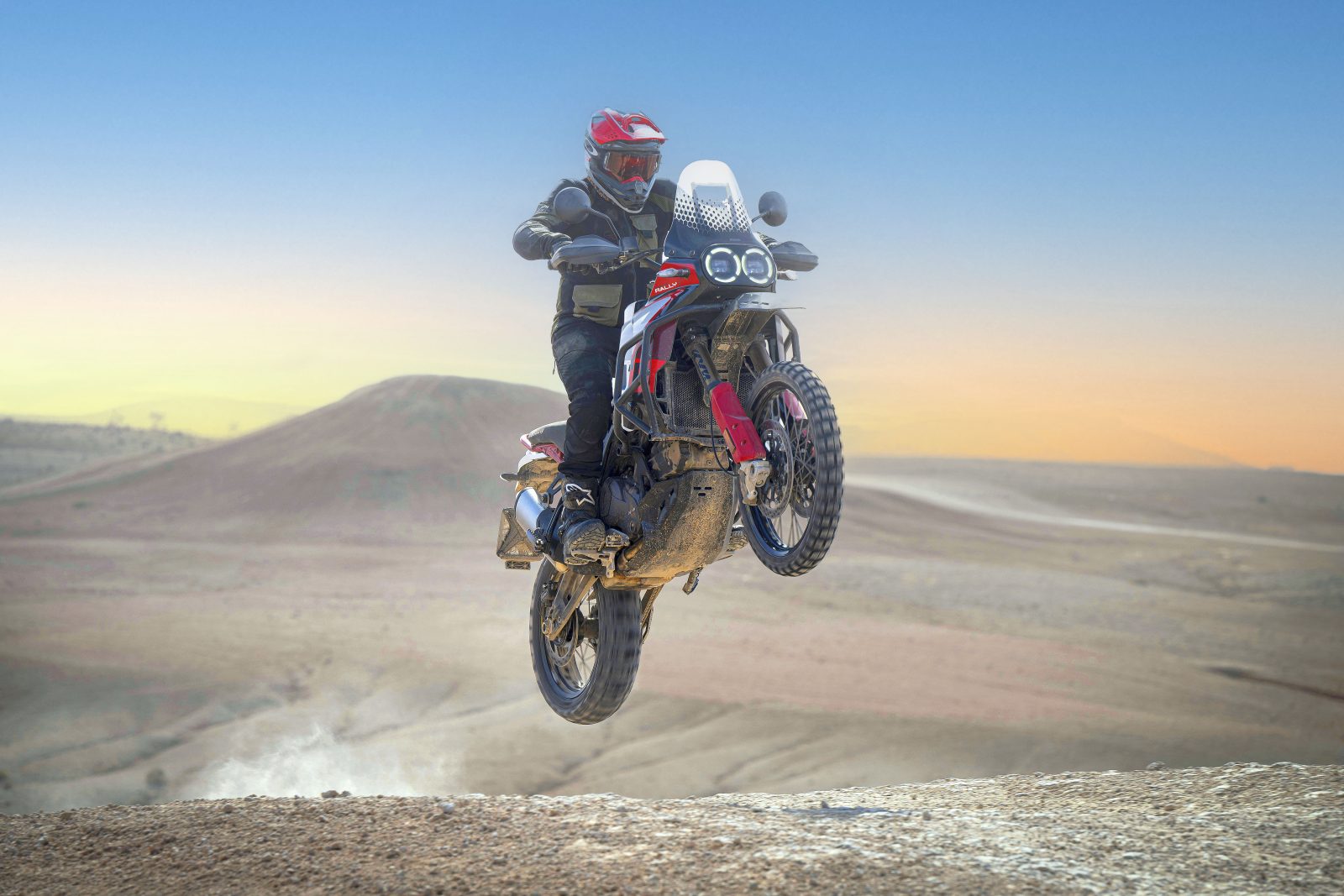
I’d not ridden a DesertX for six months but, on our two-day test in the wilds of Morocco, the new Rally instantly felt familiar, with easy-to-understand switchgear and those numerous modes and rider aids at my fingertips. In the congested streets of Marrakesh, I selected Urban mode, then opted for Sports mode on the asphalt road out of town and, when we hit the dusty trails, Enduro followed by the full-power Rally mode as the pace got hotter. All done, thank you very much, in a moment and on the move, eyes still on the view ahead.
As the conditions change, you can simply switch between the modes by quickly closing the throttle and selecting – tuning the bike’s characteristics to the terrain and the moment. It’s fast and intuitive and the dash communicates the changes clearly. The six riding modes are Sport (full power), Touring (70.8kW/95hp with a softer delivery) and Urban (55.9kW/75hp). Then Wet mode ups the intervention levels of the electronic aids, while the two off-road modes deliver 55.9kW (75hp) and a rapid throttle response in Enduro mode, and full power with minimal intervention from the ABS and traction control and none at all from the deactivated wheelie control in Rally mode.
The system is so polished and easy that it’s like having an extra control. On the dirt, I’d input Rally mode for effortless stand-up wheelies and then, for a tricky sandy section, pop it back into Enduro for less power and more support from the traction control and other rider aids – and do so without having to think about it at all.
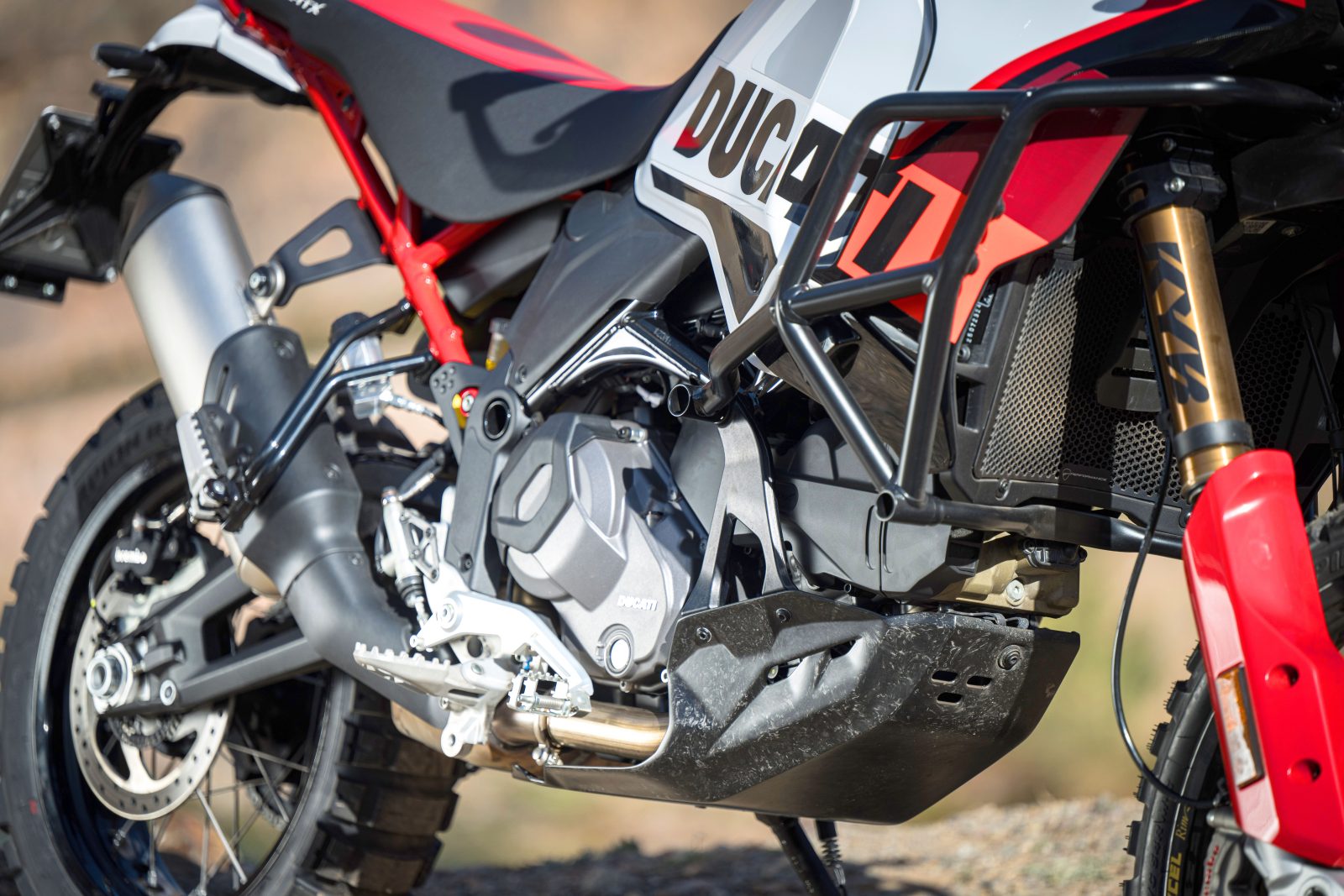
Everything in the drivetrain, from throttle to gearbox is also on point. A lovely spread of torque blends with the slickest of quickshifters to deliver perfectly metered drive. It’s smooth and willing one minute, and able to land a serious punch the next. Grab a handful of throttle in second gear with wheelie control deactivated and the front wheel will climb skywards.
But the real story of the Rally is not its engine but its chassis, because the quality of KYB suspension units is simply outstanding. Up front, the closed cartridge 48mm fork has 250mm of travel (compared to the DesertX’s 46mm diameter fork with 230mm of travel) and marginally lighter springs. The yokes are billet aluminium and give 1mm more offset. At the rear, a fully adjustable KYB shock also gets a remote spring preload adjuster. Stroke goes up from 220mm to 240mm, while ground clearance increases by 30mm to 280mm and seat height goes up from 875mm to a vertiginous 910mm making it the highest perch on any current Ducati model.
This lofty statistic may put some shorter riders off the Rally. But if you want a bike to work like a racer off-road, these are the dimensions you have to work with. Furthermore, I’m under 170cm and the altitude of the seat wasn’t as intimidating as I was expecting, mainly because both seat and bike are narrow, which meant I could get one foot securely down while just about reaching the back brake or gear selector with the other, though I did find it difficult to flick up the sidestand while onboard, and even taller riders struggled.

On paper it’s also a reasonably heavy bike (203kg dry/211kg wet, no fuel) but doesn’t feel it, even when fully fueled. What it does feel, though, is sensational. Simply, the Rally is one of the best adventure bikes I’ve ever ridden off-road.
About 90 percent of our ride was on dirt ranging from fast open dunes and desert to slow and rocky sections, and the KYB suspension was faultless throughout – so controlled it behaved as if on paved road rather than churning dirt. Like the proverbial duck that’s calm on the surface but working frantically underwater, the KYB units take everything you can throw at them and more.
I deliberately tried to provoke the Rally by slamming the throttle shut over humps to agitate the rebound. I tried hitting rocks while on the brakes. I even deliberately landed badly off jumps. And the bike soaked it all up. All day, on both days, the Rally made fast, fun dirt riding effortless. It gave me time to scan ahead, fed back everything I needed to know about grip levels, and responded to my inputs smoothly, driving impeccably through power-sapping sand and making me look so much better than I am. At 130km/h on a loose surface that would normally tense me up, I realised I was totally chilled(ish).

The 21-inch front and 18-inch rear wheels feature hubs machined from solid aluminium, carbon-steel spokes and Excel rims, with the rear rim a relatively narrow four inches in width to optimise off-road grip. Tubed Pirelli Scorpion Rally STR tyres are standard while Brembo M50 Monobloc calipers and 320mm discs do the work up front and are supported by a Brembo twin-piston caliper and 265mm disc at the rear, with cornering ABS controlled by a Bosch IMU.
Comfort remains largely untested as I stood up on the ’pegs for the majority of the ride and spent little time on the new seat. The new ’pegs are worth a mention, though, as they are wide, solid and very grippy. The gear shifter and brake pedal are both machined from solid alloy and adjustable to suit off-road or on-road use. With the rear brake pedal flipped over into its off-road position it allows you to use the back brake with rare finesse, even in off-road boots.
The DesertX Rally is expensive. Priced at $36,600 it is $10,400 above the standard DesertX ($26,200). It is however equipped with high-end components, so while the asking price is high, it’s easy to see where the money has been spent. The portrait oriented five-inch dash is, for example, pure class and has both connectivity and two display modes: standard and rally, both of which are clear and easy to read. A utility bar for extra mountings above the clocks is also a neat touch.

Our testbike was (wisely) fitted with a full external steel engine cover and radiator guard. Importantly for those who plan to ride their Rallys as intended, a couple of days in the desert, with dust and rocks being thrown in all directions, left our test machine still looking like new, with no obvious sign of wear from enduro boots covered in grit rubbing against the bodywork. Even the carbon-fibre sump guard appeared unblemished at the end of the ride.
Of course, our desert-based test leaves us in the dark about the Rally’s abilities on asphalt, but I can already state confidently it is arguably the best road-legal ‘big’ adventure bike I’ve ever ridden off-road, the suspension perhaps the finest I’ve experienced on non-road terrain.
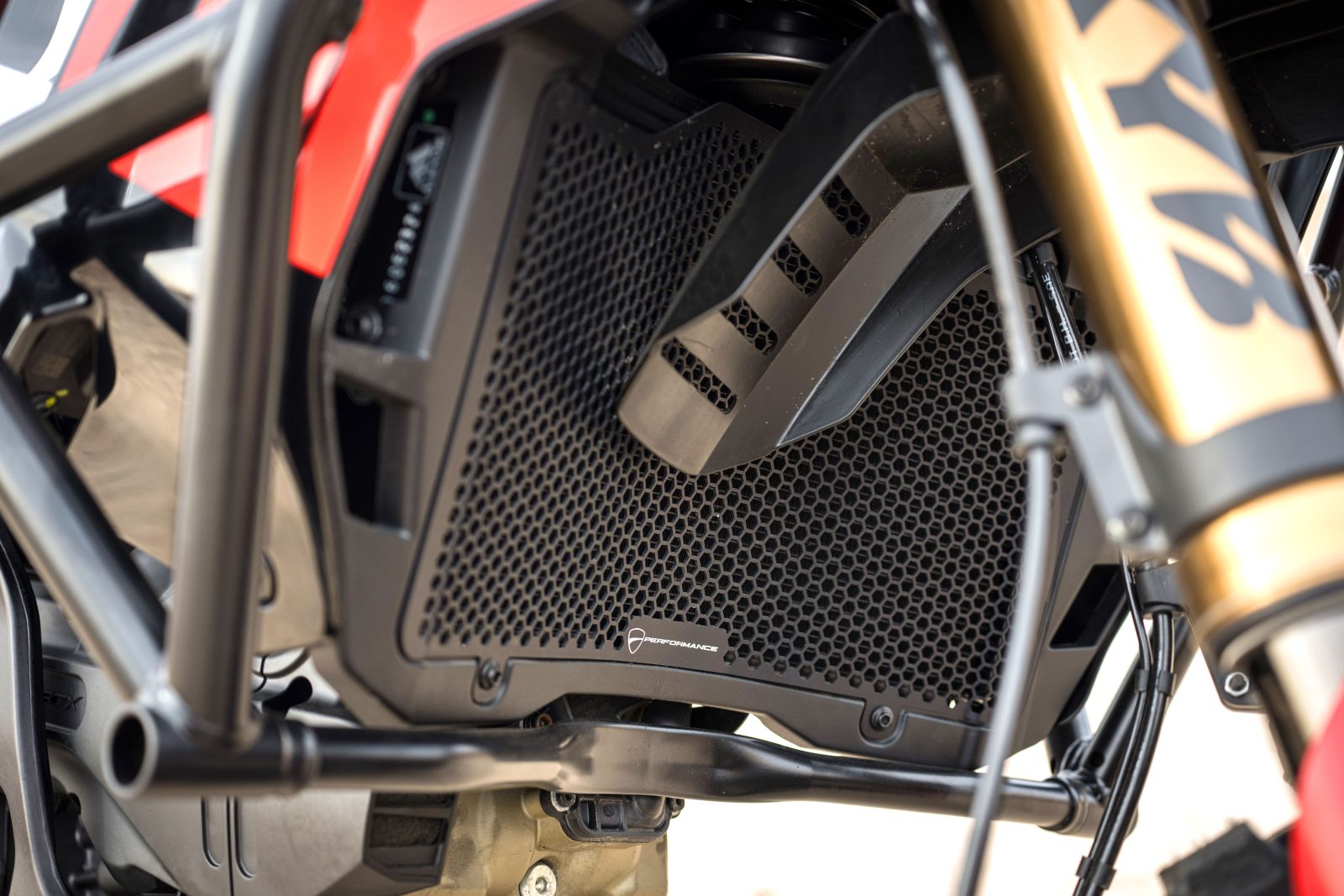
But this isn’t a radical adventure bike aimed at an extreme audience; the rider aids and modes, along with the friendly power delivery, make it versatile and usable to a wide range of riders.
Yes, the 910mm will be too tall for some and $36,600 is a lot of money, but I forgive its flaws because I’ve never ridden an adventure bike on dirt with so much confidence. And that’s priceless. We just need to clarify its on-road potential, which we will do when the bike arrives Down Under.
WORDS: ADAM CHILD PHOTOS: ALEX PHOTO
GOOD: Hugely desirable with ready-to-race (off-road) suspension and set-up, excellent rider aids and modes and a high level of finish.
NOT SO GOOD: The 910mm seat height makes the sidestand tricky to operate onboard and it’s expensive for a middleweight 80kW adventure bike.
SPECIFICATIONS
ENGINE
Capacity 937cc
Type V-twin, desmodromic valve control, four valves per cylinder
Bore & stroke 94mm x 67.5mm
Compression ratio 13.3:1
Cooling Liquid
Fueling EFI, 2 x 53mm throttle bodies
Transmission Six-speed
Clutch Wet, multi-plate, slipper type
Final drive Chain
PERFORMANCE
Power 81kW (108hp) @ 9250rpm (claimed)
Torque 92Nm @ 6500rpm (claimed)
Top speed 180km/h (est)
Fuel consumption 5.6L/100km (measured)
ELECTRONICS
Type Not given
Rider aids Engine brake control, cornering ABS, traction control and wheelie control
Rider modes Sport, Touring, Urban, Wet, Enduro and Rally
CHASSIS
Frame material Tubular steel
Frame type Trellis
Rake 27.6°
Trail 122mm
Wheelbase 1625mm
SUSPENSION
Type KYB
Front: 48mm upside-down fork, adjustable compression and rebound, 250mm travel
Rear: Monoshock, fully adjustable, 240mm travel
WHEELS & BRAKES
Wheels wire-spoked aluminium
Front: 21 x 2.15
Rear: 18 x 4.0
Tyres Pirelli Scorpion Rally STR
Front: 90/90-21
Rear: 150/70-18
Brakes Brembo
Front: Twin 320mm discs, twin-piston caliper
Rear: Single 265mm disc, twin-piston caliper
DIMENSIONS
Weight 211kg (wet, no fuel, claimed)
Seat height 910mm
Width Not given
Height Not given
Length Not given
Ground clearance 280mm
Fuel capacity 21L
SERVICING & WARRANTY
Servicing First: 1000km
Minor: 15,000km
Major: 30,000km
Warranty Two years,
unlimited kilometres
BUSINESS END
Price From $36,600 (ride away)
Colour options Red/white
CONTACT
www.ducati.com/au
